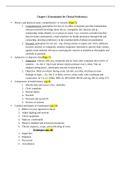Chapter 1 (Foundations for Clinical Proficiency)
History and physical exam: comprehensive vs focused ( Page. 5)
1.Comprehensive: appropriate for new pt. in office or hospital, provides fundamental and personalized knowledge about the pt., strengthens the clinician and pt. relationship, helps identify or r/o physical causes r/t pt. concerns, provides baseline data for future assessments, creates platform for health promotion through Edu and counseling, develops proficiency in the essential skills of physical examination. 2.Focused: appropriate for est. pts – esp. during routine or urgent care visits, addresses focused concerns or symptoms, assesses symptoms restricted to specific body system,
applies exam methods relevant to assessing the concern or problem as thoroughly and
carefully as possible. Subjective vs objective data (Page. 7)
1.Subjective : what pt. tells you, symptoms and hx from chief complaint thru review of systems… ex: Mr. G 54y/o hair dresser reports pressure over L/chest “like an elephant sitting there”, which goes into her L/neck & arm.
2.Objective: What you detect during exam, lab info, test data, all physical exam findings or signs… Ex: Mr. G is older, overwt, white, male, who is pleasant and cooperative, ht 5’4, wt 150lbs, BMI 26, BP 160/80, HR 96 and reg, RR 24, temp 97.5.
Components of health history (pg. 8)
1.Identify data and source of hx: reliability
2.Chief complaint
3.Present illness
4.Past HX
5.Personal and social HX
6.Review of systems
Cardinal techniques of examination ( pg. 14)
1.Reflect on your approach to the pt.
2.Adjust lighting and environ
3.Check equipment
4.Make pt. comfortable
5.Observe standard and universal precautions
6.Choose sequence, scope, and positioning of exam
-Techniques ( pg. 18) 1.Inspection
2.Palpation
3.Percussion
4.Auscultation Clinical reasoning, assessment, and plan ( pg. 25)
1.Clinical reasoning: Pattern recon, development of schemas, application of relevant basic and clinical science
2.Assessment: subjective data, obj data, problem action plan
3.Plan: wide range and includes pt edu, change in meds, needs for test, referrals, return visits, counseling and support
Generating the problem list (pg. 25/37)
1.Identify abnormal findings
2.Localize findings anatomically
3.Cluster findings: pt. age, timing, involvement of dif body systems, multisystem con, key questions
4.Search for problem/cause of findings
5.Generate hypothesis and test
6.Est. working DX
7.Use shared discussion making to devlop plan
Problem list: summarizes pt. problems that can be placed in the front of the office or hospital chart. List the most active and serious problems first and record their date of onset. Good problem list help individualize pt care. Chapter 2 (Evaluating Clinical Evidence)
Sensitivity and specificity ( page. 48)
1.Sensitivity: the probability that a person with disease has positive test. This is represented as an a/(a+c) in the disease present column of 2X2. Sensitivity is aka the true positive rate. 2.Specificity: the probability that a non-diseased person has a neg test. Represented as d/(b+d) in the disease absent column of 2X2 table. Specificity is aka the true neg rate.
Chapter 3 (Interviewing and the Health History)
Different kinds of health histories: comprehensive vs focused (pg. 67)
1.Comprehensive: New pt in most settings, a specialist may need a comprehensive HX to evaluate a problem with numerous possible causes
2.Focused or problem oriented: pt seeking specific concerns for ex cough, painful urination, limited interview tailored to the specific problem may be indicated. Pt seeking care for ongoing chronic problems, self management, response to TX, func capacity, QOL, health maintenance visits with focused goals of keeping screening up to date, discussing concerns like smoking/wt. loss/sex.
Skilled interviewing techniques/Sequence and context of the interview ( pg. 67)




